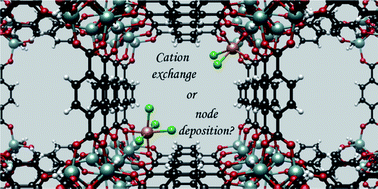Quo vadis niobium? Divergent coordination behavior of early-transition metals towards MOF-5†
Abstract
Treatment of MOF-5 with NbCl4(THF)2 in acetonitrile leads to incorporation of Nb(IV) centers in a fashion that diverges from the established cation metathesis reactivity of this iconic material. A combination of X-ray absorption spectroscopy analysis and reactivity studies altogether supported by density functional theory computational studies document an unprecedented binding mode for the Zn4O(O2C–)6 secondary building units (SBUs), which in Nb(IV)-MOF-5 function as κ2-chelating ligands for NbCl4 moieties, with no exchange of Zn2+ observed. This unusual reactivity expands the portfolio of post-synthetic modification techniques available for MOFs, exemplified here by MOF-5, and underscores the diverse coordination environments offered by this and potentially other MOFs towards heterometal species.

- This article is part of the themed collection: 2019 Chemical Science HOT Article Collection


 Please wait while we load your content...
Please wait while we load your content...